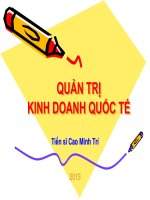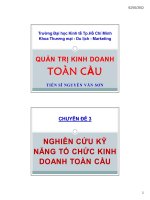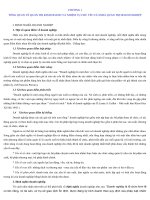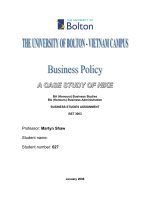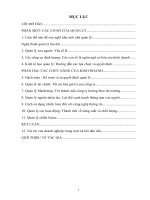Bài giảng quản trị kinh doanh ppsx
Bạn đang xem bản rút gọn của tài liệu. Xem và tải ngay bản đầy đủ của tài liệu tại đây (271.02 KB, 21 trang )
BA (Honours) Business Studies
BA (Honours) Business Administration
BUSINESS STUDIES ASSIGNMENT
BST 3003
Professor: Martyn Shaw
Student name:
Student number: 627
January 2008
UNIVERSITY OF BOLTON
BOLTON BUSINESS SCHOOL
Business Studies Pathway
Module Name and number: Exploring Corporate Strategy
(BST3004)
Tutor: Martyn Shaw
Assignment Number: One Weighting: 50%
Assignment Title: Nike Strategy Fit
Assignment Length: 2500 Words
Issue Date: December 2007
Submission Deadline: 8
h
February 2008
I declare this submission to be my own work.
Signed (student name)……………………………………………….
Date…………………………………………………………………….
2
I. INTRODUCTION
Following the Forbes 2000 public companies, we've taken the ten
countries and listed the top-ranking enterprise in each. Most of these global
giants have brand names can see around the world. Nike is among the multi
company with the largest seller of designs, develops and markets athletic, market
quality footwear, active sports, equipment and accessory product.
This assignment aims to use knowledge and understanding of strategic fit,
competitive strategies, competitive advantage to evaluate as well as to explain
that success of company in 2004 till now.
II. STRATEGY ANALYSIS
Part 1: Evaluating the extent to which Nike has achieved strategy fit.
The strategic fit will bring more benefits for Nike. Because of Nike’s using well
strategic fit to cost decrease, due to economies of scale, transfer of knowledge
and skills. Now the assignment will apply four Model, PEST (Political, Economic,
Social, and Technological), Five Forces, and The Value Chain, SWOT (Strength,
Weakness, Opportunity, and Threat)
1. External Environment Analysis:
1.1 Macro Environment Analysis: (PEST Analysis)
When the economics’ development and how the Nike’s use the position of
strength. In addition, Nike has the strategic. The Model PEST had four steps,
Political, Economic, Social, and Technological
Political Factors:
Political and
government policy
influences economic
conditions with a major
influence affecting
government decisions.
3
The policy always secures independent monitoring for our factories, to improve
safety and health conditions
Economic Factors:
The economic have influence in the industry footwear. In other country, as
the economy slows in the U.S, consumer purchases are down. And with the
terror that is the economy, costs and prices are up.
Sociocultural Factors:
People’s lifestyles are changing towards their diet and health. As
predication , an increase in the number of people joining fitness clubs and a
massive growth for the demand of healthier sports shoes, and tastes with vary
with fashion, pricing and promotion strategies.
Technological Factors:
In the Word that new technology could provide a useful input, creating
new industries, featuring new print and television advertising
1.2 Industry Structures Analysis: (Nike’s Porter’s Five Forces
Analysis)
4
The Five Forces affecting competition in an industry
(Adapted from M. E. Porter, Competitive Strategy, Free Press (1980), page 4)
Barriers to Entry: low
All companies had the competitor for customer, design, marketing, and prices.
Purchase prices for Nike’s products cheaper more than the different companies.
Customer’s loyalty products from others big companies Adidas-Salomon AG and
Reebok are very high.
Stronger companies have larger, more diverse distribution channels, which helps
them fend off the inevitable problems that strike industries from time to time the
name Nike inspires innovation and quality, an experience that consumers want to
be a part of.
.
Bargaining Power of Buyers and Suppliers:
Buyers in the footwear industry enjoy a largest contract of power. Nike
should continuously market their product and differentiate their brand competitor
in raise sales and market share. Nike had a website “nikeid.com” connect allows
consumers to customize and design the product when the customer need and
the choices to personalize the footwear with their name.
The power of buyers is very high, because they have many choices.
Consumer references in the market have a significant influence. By new
technologies for the products, update the design, promotion and so on to notice
buyers
5
Threats of Substitutes: low.
The cheap products of China will make threats against Nike. For
example: In fiscal 2004, China was imported 23.8 million pairs of footwear in total
value of $481.3 million. Especially Chinese will imports the EU growing up 700%
in 2005. Because of China is a country appearing socioeconomic development
quickly in the world, besides Chinese could increase product s footwear and
decrease the prices of product. EU is a decline in the market share for Nike with
other company.
Rivalry among Existing Competitors: high.
Nike is the strongest brand in the world so it is dominating the market,
besides some popularizes brands such as Adidas, Reebok, Puma. There are
many competitions among the footwear companies. Example:
1.3 Stakeholders:
Nike is a high situation in footwear industry. Besides it had been to relationship
with lot stakeholders such as product trade unions, business reaction, investors
and other. For example: Nike has relationship with Apple and product Nike Apple
and then Nike will be product more produces can adjust with everybody in the
world. Stakeholders will make more build valuable relationship.
6
2. Company Analysis:
2.1 Nike’s Resources – Capabilities – Core Competencies:
The company’s sells its products were sold through approximately 28,000 retail
accounts and 21 sales offices in the United States. Beside, Nike are using
product outsourcing the most production occurred in Bangladesh, China, Greece,
Honduras, India, Indonesia, Malaysia, Pakistan, the Philippines, Sri Lanka,
Taiwan, Thailand, and Turkey.
Nike brands name are inspired by mission, vision. The company strategic plan is
make the long-term vision and the brand strategy will help the company identify
why and how it will achieve those goals.
In addition, Nike outstanding performance in three primaries organizational
function that creates superior value for its customers thus creating competitive
advantage and competitive strategies
.
Nike’s core competencies had three identified financial, marketing and
advertising, research and development. Nike’s to maintain dominant position in
the athletic footwear industry. Furthermore, the company has the good
demonstrated the ability to manage and utilize these resources better than
another company. Nike has grown to be tremendous advantage for the company
when commerce with their competition, customers and moreover creating high
entry barriers for other company
2.2 Porter’s Value Chain Analysis:
7
Primary Activities:
Inbound Logistics:
Most important value attrition in production with payable attentiveness of Nike
associated making services as well as on-going measures.
Operations:
The new inventiveness will be developing systems and processes disturbed with
identical the supply and demand of products. Estimated will be increasing profits,
margins and cash flows of Nike throughout decrease rejoinder time, allocation
costs and inventories.
Outbound Logistics:
The futures in both the US and overseas will demonstrate come back to a
successful model subsequent weak festival season, Olympics and difference with
Foot Locker.
Marketing and Sales:
Nike have successful with marketing, a significant of sales, another disturbed
with demand manufacture and advertisement.
Service:
The supply network products of Nike have over the world. People can buy
products in stores and outlets. Beside Nike had a website www.nikeid.com, when
customer need design product and write idea for Nike.
Support Activities:
Procurement:
Nike is footwear product uses the materials and applying material in the country
the company outsourcing: natural, plastic, nylon, leather, synthetic rubber, foam,
canvas and polyurethane company used to make develop AIR-SOLE
8
Technology Development:
Nike always creates new products and design in compliance with client's liking.
Corporation is still applicator many method small tables are as Nike is the first
using the new technology” Air” and developing by Marion Frank Rudy.
In addition, Nike was product a more produces Jordan, Nike air force, Nike air
max 2003, Nike air max 2004 and so on
Human Resource Management (HRM):
In around the world, Nike has more than 30,000 people globally. The HMR have
more the outsourcing in the Vietnam, China, Indonesia and Thailand
manufactured 22%, 36%, 24%, and 16% of total Nike in 2004. All most workers
have good skills and abilities to construct the high value products.
Firm Infrastructure:
.
Nike, Inc headquartered in the United States near Beaverton, Oregon and
product outside the United States (US) thought a mix of independent distributors,
licensees, and subsidiaries in 200 countries around the world.
3. Nike’s SWOT Analysis:
9
Strengths:
Nike has one companies strong brand name and captured the largest
market share in the global foorwear and apparel industry.Nike has a healthy
dislike of is competitors such as Adidas, Puma…It can produce high quality
product at the lowest price. It use to outsourcing from Asia, Africa…because it
pay a little expense for labor.
Weaknesses:
Nike is the largest division and relies frailly heavily in the market. Nike’s
products are considered to be of higher quality and highest prices relative to our
competitors with other company and have a relationship with Footlocker. Nike are
placing emerging technology and innovation towards development of new
product.
Opportunities:
.
The currently strong economic will bring benifit in the athletic footwear
and apperal industrial. International profitability is growning up quickly as well as
the invesment marketing and operations in the US. Nike can also benefit from
benefit from taking advantage of its strong relationships with large quality-
focused retailers within Europe.
Threats:
Nike is the leader in the footwear and apparel industrial but its must
competitor with other company like that Adidas, Reebok. The launch of
technologically higher by Nike’s competitor with the new technology Nike Air in
2004.In March 2005, Adidas and Reebok has the products new technology
Adidas released Adidas 1 and Reebok pump 2 .0.
10
Part 2: Critically discussing the extent to which the level of strategic fit
achieved by Nike supports its competitive strategies.
Nike has been using mission and vision very successful
The Nike mission: To bring inspiration and innovation to every athlete in the
world. If you have a body you are an athlete.
This vision strategy is to:
• Cultivate diversity and inclusion to develop world-class, high-performing
teams.
• Ignite change and inspire critical conversation around diversity, inclusion
and innovation.
• Create venues and environments for open dialogue, diverse opinions and
a multitude of perspectives
(Source: />Nike’s believes that its achievement bases on the teammates, customers,
shareholders. Nike marketing and sales strategy are also an important factor of
the company
Ansoff’s Matrix Analysis:
Nike use model Ansoff Matrix, With Nike grown up its for company strategies
during 4 main strategies: market penetration strategy, market development,
product development, diversification.
11
The market penetration: Nike is development and investments in branding to
retain advanced of product loyalty in its obtainable customer. Strategy of Nike is
expressly focuses detaining offering customers and making brand loyal
Market development: Nike is a globalization company; the products have buy
around the world, but Nike always development can adapt with everybody. In
2004, Nike was opening 13 NIKETOWN. Beside, the center in Europe, Asia,
Australia, Latin America, Africa and Canada had operated 23 distributors of Nike.
Product development: When the strategy of the more than company strong as
thought Adidas-Salomon and Reebok. Nike’s design more product adapt with
every body .Example Nike Air is obtaining people like using more compare with
another product for the different company. So on it is products relationship with
consumer.
Strategy fit:
Nike selection offers significant strategic fit, its benefits between many of its
sporting goods businesses. Purchasing economies and skills transport between
the apparel and footwear industrial (Nike Golf, Nike Pro, Nike +, Air Jordan, Team
Starter) container be readily achieved. Furthermore, strategic fit benefits are
possible in the product growth and production behavior of its apparel and
footwear. The brand building, sales, design and marketing activities of all
businesses are very similar and offer significant skills convey benefits across the
company in over the world.
The strategic choices “fit‘s” because opportunities in purchasing, product
development, or production between Nike apparel and footwear businesses and
its sports equipment products (tennis, golf, soccer, baseball, football, bicycling,
volleyball, wrestling, cheerleading, aquatic activities, hiking). In addition, there
seems to belittle opportunity to capture synergistic benefits between Nike
relationships Apple's iPod Nano called the Nike + iPod Sport Kit. The purchasing,
product design, and production activities for leisure and other athletic are likely
very dissimilar. Similarly, the customer service activities of these business groups
could ignore to retailer queries concerning equipment or apparel.
.
Product Life Cycle :
Product life cycle is minimize of Nike because every year Nike have product
more than 50,000 produce new in 2007, the environmental had contact of each
product during its life cycle from ultimate disposal, design and post consumers
use
12
Testing Strategic Choices (Johnson & Scholes choice tests)
Nike is “fit” by using Johnson& Scholes choice tests
Suitability: The strategic will been “fit” in the future but also it can changes when
the environment and economic changes. Nike has force away the threat of
decrease prices when the Nike product outsourcing in China. After that China’s
have cheap price shoes by more new lifestyles and technology
Acceptability: Nike’s can get more revenue, benefit from shareholders. Nike has
a strong in the plan and capability to explain the threat and understand the
shareholders needs in Nike.
Feasibility: Nike’s the successful in the product outsourcing in over the world. It
would be strong resources and competences to distribute strategy. How Nike can
get more profit and decrease to spend on build factor. It can combine with
together and development strategy
Part 3:
Based upon the current strategic position of Nike (year 2004), the
assignment will critically assess its potential competitive position over the
next 5 years.
Nike’s marketing research and make decisive to restore its apparel division to be
more fashion confidence, and understand lifestyle everybody. The same as result
of product and pricing research, Nike has decided to maintain to focus on the
high and market though growing it’s the market share with the competitor by
Adidas, Reebok in the middle and low price ranges in an attempt to expand. Nike
had to evaluate the economic trend of domestic and international markets during
the planning arena. The force of the market, technological advancements, and e-
business which is quickly growing. Furthermore, Nike has been strategic
improved image and brand name in the world.
In 2004 to 2007, the vision and mission of Nike, the strategies “fit” and revenues
always increase year to years. In the future, 2007 to 2012 the strategic will
improve technology and develop the strategy of mission and vision. Company will
be successful and get more revenue. An especially, Nike have more design
adapt with every people and low a prices. Because of Nike’s failure foresee
13
problem in relation to labor and factory in India, when the Nike’s use the plan
outsourcing. Nike should be careful when using the outsourcing in the different
country. Because of Nike must understand culture before investment open
outsourcing and open retail. Beside Nike have a good marketing and sales in the
highest compare the company competition. But Nike needs marketing and
advertising suitable with culture of every country Nike sales product.
The company is rethinking some of its long-standing agreements with retailers,
particularly during the retail industry's consolidation push in 2005. The company
will keep the strategy “fit” development brand name and on the competition.
When the Adidas acquired Reebok in 2006.the deal put the attached companies
in a position to compete with longstanding rival NIKE, which has been the summit
spot in the footwear markets international for decades. Nike will be high profit,
customer and strong brand name. In the next five year Nike should the top
number one in the athletic appral and footwear industry. Besides, Nike has to
develop technology in order to create fashionable, comfortable and good for
health products
14
III. BIOLOGRAPHY
Clayton M. Christens and Michael E. Raymor (2003). The Innovator’s Solution:
Creating and Sustaining Successful Growth. Harvard Business School
Publishing.
Draft, R. (2007) Understanding the theory and design of organizations, Mason,
OH, Thomson South-Western
Michael E. Porter (1980), Competitive Strategy: Techniques for Analyzing
Industries and Competitors. New York: Free Press.
Michael E. Porter (1985). Competitive Advantage. New York: Free Press.
Michael E. Porter (November-December 1996). What Is Strategy? .Harvard
Business Review
Michael E. Porter (1998) .On Competition, Boston, MA, The Harvard Business
Review.
Marshall L. Fisher (March- April 1997). What Is The Right Supply Chain For Your
Product. Harvard Business Review.
Gerry Johnson, Kevan Scholes, Richard Whittington (2005). Exploring Corporate
Strategy: Text and Cases (7
th
ed.). Spain: FT – Prentice Hall.
John A. Pearce II, Richard B. Robinson, Jr (2007). Strategic Management:
Formulation, Implementation, and Control (10
th
ed.). McGraw-Hill Companies.
Johnson, G. Scholes, K. and Whittington, R. (2005) Exploring Corporate strategy
(7th edn) London, Prentice Hall.
Pearce, J. and Robinson, R. (2007) Strategic Management (10th edn), New York,
NY, McGraw-Hill.
Hannagan, Tim (2004). Management concepts and practices (4
th
edition). FT -
Prentice Hall.
Katz, Michael and Carl S. (1994), Systems Competition and Network Effects,
Journal of Economic Perspectives.
15
Enterprise and Industry- Footwear Homepage. Overview Of The Footwear
Industry. Retrieved November 29, 2007, from
/>Nike, Inc., (n.d.). Introduction about Nike, Incorporated. Retrieved November 25,
2007, from />Nike Strategy. Core Competence. Retrieved December 25, 2007, from
/>Golden Essays, (n.d.). Nike. Retrieved December 1, 2007, from
/>Diversity & Inclusion, (n.d) Diversity Helps Drive Success. Retrieved
November 28, 2007, from />Marketing Teacher Lesson Store, (n.d.). Theory of PEST Analysis. Retrieved
November 25, 2007, from
/>Marketing Teacher Lesson Store, (n.d.). Theory of Porter’s Five Forces Analysis.
Retrieved November 25, 2007, from
/>Marketing Teacher Lesson Store, (n.d.). Theory of Porter’s Value Chain Analysis.
Retrieved November 25, 2007, from
/>Marketing Teacher Lesson Store, (n.d.). Theory of SWOT Analysis. Retrieved
November 25, 2007, from
/>Marketing Teacher Lesson Store, (n.d.). Theory of Core Competences. Retrieved
November 25, 2007, from
/>Marketing Teacher Lesson Store, (n.d.). Theory of Ansoff's Matrix. Retrieved
November 25, 2007, from
/>Global Vista, (n.d.). Nike on Global Economics. Retrieved November 30, 2007,
from />x=b11,0,w
16
Organic Consumers Association, (n.d.). Nike Social Responsibility Rhetoric
Exposed as a Lie. Retrieved November 30, 2007, from
/>Strategic Analysis of Nike, Inc., (n.d.). Nike’s Strategic Analysis. Retrieved
December 12, 2007, from
/>The Manufacturing Practices of Nike and its competitors, (n.d.). The
Manufacturing Practices of the Footwear Industry: Nike vs. the Competition -
Steven Van Dusen. Retrieved December 20, 2007, from
/>Investors, (n.d). Nike Is A Growth Company. Retrieved December 14, 2007 from
/>17
18
19
20
21

